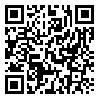Volume 15, Issue 3 (Vol.15, No.3 2019)
irje 2019, 15(3): 226-234 |
Back to browse issues page
Download citation:
BibTeX | RIS | EndNote | Medlars | ProCite | Reference Manager | RefWorks
Send citation to:



BibTeX | RIS | EndNote | Medlars | ProCite | Reference Manager | RefWorks
Send citation to:
Aflatoonian M, Nadim A, Sharifi I, Bamorevat M, Tajik S, Hashemian M, et al . Comparison of Morbidity Rate and Transmission Cycle of Cutaneous Leishmaniasis in Two New Foci in East and Southeast of Kerman, 2017. irje 2019; 15 (3) :226-234
URL: http://irje.tums.ac.ir/article-1-6382-en.html
URL: http://irje.tums.ac.ir/article-1-6382-en.html
MR Aflatoonian1 
 , A Nadim2
, A Nadim2 
 , I Sharifi3
, I Sharifi3 
 , M Bamorevat4
, M Bamorevat4 
 , S Tajik5
, S Tajik5 
 , M Hashemian6
, M Hashemian6 
 , R Abasi Rayeni7
, R Abasi Rayeni7 
 , R Shabanzadeh7
, R Shabanzadeh7 
 , B Aflatoonian *
, B Aflatoonian * 
 8
8

 , A Nadim2
, A Nadim2 
 , I Sharifi3
, I Sharifi3 
 , M Bamorevat4
, M Bamorevat4 
 , S Tajik5
, S Tajik5 
 , M Hashemian6
, M Hashemian6 
 , R Abasi Rayeni7
, R Abasi Rayeni7 
 , R Shabanzadeh7
, R Shabanzadeh7 
 , B Aflatoonian *
, B Aflatoonian * 
 8
8
1- Assistant Professor, MPH, Research Center for Tropical and Infectious Diseases, Kerman University of Medical Sciences, Kerman, Iran
2- Professor, PhD, Iranian Scientific Epidemiology Association, Iran
3- Professor, PhD, Leishmaniasis Research Center, Kerman University of Medical Sciences, Kerman, Iran
4- PhD, Leishmaniasis Research Center, Kerman University of Medical Sciences, Kerman, Iran
5- PhD, Research Center for Tropical and Infectious Diseases, Kerman University of Medical Sciences, Kerman, Iran
6- Assistant Professor, MD, Research Center for Tropical and Infectious Diseases, Kerman University of Medical Sciences, Kerman, Iran
7- MD, Research Center for Tropical and Infectious Diseases, Kerman University of Medical Sciences, Kerman, Iran
8- Researcher, Msc, Neuroscience Research Center, Kerman University of Medical Sciences, Kerman, Iran ,Afatoonianbehnaz@gmai.com
2- Professor, PhD, Iranian Scientific Epidemiology Association, Iran
3- Professor, PhD, Leishmaniasis Research Center, Kerman University of Medical Sciences, Kerman, Iran
4- PhD, Leishmaniasis Research Center, Kerman University of Medical Sciences, Kerman, Iran
5- PhD, Research Center for Tropical and Infectious Diseases, Kerman University of Medical Sciences, Kerman, Iran
6- Assistant Professor, MD, Research Center for Tropical and Infectious Diseases, Kerman University of Medical Sciences, Kerman, Iran
7- MD, Research Center for Tropical and Infectious Diseases, Kerman University of Medical Sciences, Kerman, Iran
8- Researcher, Msc, Neuroscience Research Center, Kerman University of Medical Sciences, Kerman, Iran ,
Abstract: (2826 Views)
Background and Objectives: Cutaneous leishmaniasis (CL) is one of the health problems in Iran, especially in Kerman Province. The aim of this study was to determine the morbidity rate of CL in two new foci in the east and southeast of Kerman.
Methods: At the end of 2017, demographic data were obtained from the health centers of Kerman. Using cluster sampling, 800 households (40 clusters of 20 households) were studied in Allahabad (southeast) and Sarasiab (east), Keramn. From each subject, data were collected regarding age, sex, number and location of the ulcer(s), scarring, and time and place of infection. The collected data were analyzed using SPSS software.
Results: The prevalence of CL was 9.6 in Allahabad and 42.8 in Sarasiab and the incidence (new cases) was 3.2 and 3.8, respectively. The highest rate of infection was found in Allahabad in the age group under 6 years old and in the Sarasiab was over 40 years old. There was a significant difference in nationality and local transmission between the rwo regions (P <0.001).
Conclusion: The ratio of the prevalence to incidence in two regions showed that the focus in the east of Kerman was almost 12 years old, whilst a new focus is developing in the southeast. It is suggested that the health centers in the city of Kerman provide a regular program including active case- detection and free-of-charge treatment of patients in the aforementioned areas until complete recovery to achieve disease control.
Methods: At the end of 2017, demographic data were obtained from the health centers of Kerman. Using cluster sampling, 800 households (40 clusters of 20 households) were studied in Allahabad (southeast) and Sarasiab (east), Keramn. From each subject, data were collected regarding age, sex, number and location of the ulcer(s), scarring, and time and place of infection. The collected data were analyzed using SPSS software.
Results: The prevalence of CL was 9.6 in Allahabad and 42.8 in Sarasiab and the incidence (new cases) was 3.2 and 3.8, respectively. The highest rate of infection was found in Allahabad in the age group under 6 years old and in the Sarasiab was over 40 years old. There was a significant difference in nationality and local transmission between the rwo regions (P <0.001).
Conclusion: The ratio of the prevalence to incidence in two regions showed that the focus in the east of Kerman was almost 12 years old, whilst a new focus is developing in the southeast. It is suggested that the health centers in the city of Kerman provide a regular program including active case- detection and free-of-charge treatment of patients in the aforementioned areas until complete recovery to achieve disease control.
Type of Study: Research |
Subject:
Epidemiology
Received: 2019/12/11 | Accepted: 2019/12/11 | Published: 2019/12/11
Received: 2019/12/11 | Accepted: 2019/12/11 | Published: 2019/12/11
Send email to the article author
| Rights and permissions | |
 |
This work is licensed under a Creative Commons Attribution-NonCommercial 4.0 International License. |



